Intel Skylake Z170 Motherboards: A Quick Look at 55+ New Products
by Ian Cutress on August 5, 2015 7:59 AM ESTMSI Z170: Gaming MX Range
Followers of the motherboard industry will recognize that MSI has been on a gaming binge as of late. Almost everything out of MSI that ends in the hands of general consumers is in some way part of the Gaming brand, and each generation it seems to grow and grow. MSI’s take on Z170 also exhibits some major changes, wherein almost every motherboard has ‘gaming’ in the title. It would also seem that the OC Certified line of overclocking motherboards from MSI has been merged into the Gaming brand, so what was once the XPower now becomes the XPower Gaming Titanium Edition. MSI is also changing up the styling a little as well, experimenting with different colors and a wide range of RGB applications on several models.
MSI Z170A Gaming M9 ACK
At the top of the line sits the M9 ACK. MSI’s Gaming number scheme is going to confuse a number of people because in this instance, M does not mean micro-ATX as it does on other models. MSI is merely using it to differentiate between other manufacturers that also use the ‘Gaming’ nomenclature by implying that this M is for ‘Master’. But the ACK part of the name refers to the use of a Killer E2400 network port with the Killer 1535 802.11ac 2T2R dual band WiFi, both of which can be used in tandem for directing prioritized network traffic selected in software and promoting UDP transfers.
The Gaming M9 ACK takes things a little differently to the normal motherboard implementation. The power delivery heatsink doubles up as an air and water cooling solution whereby the user fits their barbs into the block. The PCIe layout also shows these two silvery bits over the slots – these are meant to be slot protectors. According to some manufacturers, slots have been destroyed when putting in heavy graphics cards and then transporting the system (in one case, we saw images which referred to TSA breaking a system in order to look at suspicious parts because they didn’t lnow how to take out the graphics cards). The purpose of these ‘steel armor’, or so MSI calls it, is to prevent the PCIe slots warping in this instance.
The PCIe layout gives x8/x8 arrangement in the steel slots with a PCIe 3.0 x4 in the middle which seems to come from the chipset. Above both of the steel slots is an M.2 slot in PCIe 3.0 x4 mode which both act as the storage hub alongside six SATA 6 Gbps ports and two SATA Express ports. Perhaps somewhat surprisingly, the three single PCIe 3.0 x1 slots on the board are all open ended, allowing for larger PCIe cards when needed.
The nib on the bottom right of the front of the motherboard should also be pointed out. Previously MSI used the term ‘OC Genie’ to refer to their one-button automatic overclock system. After years of requests, MSI has finally upgraded it to a multi-stage overclocking utility, this time using a twist dial that sequentially raises the CPU frequency and voltage. In fact, this one goes up to 11 – literally.
The rear panel shows the dual stream Killer WiFi along with a gaming port, a BIOS Flashblack slot, a USB 3.1-A, a USB 3.1-C and video outputs via the Displayport and HDMI. It’s worth noting here that the USB 3.0 ports and the USB 3.1 ports are both red, making it somewhat confusing. To make matters worse, MSI uses the USB 3.1 Gen1/2 terminology on its datasheets – to clarify, ‘USB 3.1 Gen 1’ is technically USB 3.0 whereas ‘Gen 2’ is actually USB 3.1.
The M9 ACK is meant to be the flagship motherboard for covering MSI’s new audio relationship with Nahimic audio. As a result this means we get an upgraded CMedia CM6632 audio processor solution paired with an ‘Xtreme Audio DAC’. I’m sure when the board comes out we will see exactly what that means, but it’s worth noting that the EMI covering over the audio segment of the motherboard goes quite far down and around the bottom. This is because the M9 ACK comes with a rear stiffened panel to help with motherboard rigidity:
I am told that the MSI Gaming M9 ACK will have a UK MSRP of £320. Take away tax and convert to USD gives $415, making it one of the most expensive Z170 motherboards.
MSI Z170A Gaming M7
We’ve had the Gaming M7 in for testing for over a week, despite initially getting what seemed like a dodgy sample that was more an early defect than anything serious. But the styling goes forth and continues with the MSI Gaming dragon and rear IO panel cover. Similar to the M9 ACK we get two active PCIe slots and another PCIe 3.0 x4 from the chipset.
The M.2 slots here are almost a headache to work out, but basically one is M.2 PCIe 3.0 x4 enabled and the other is SATA only, except when a SATA M.2 is used it will disable a pair of SATA ports on the board. This method could have been made simpler by just using four lanes from the chipset on each of the M.2 slots, but this is the direction MSI decided to use.
The Gaming M7 also comes with the Killer E2400 NIC, but this time the regular Realtek ALC 1150 audio solution is used. USB 3.1-A and 3.1-C ports are on the rear, but similarly to the M9 they are colored red and match the USB 3.0 ports. Current pricing puts the M7 at £180 in the UK, which translates as $230 stateside.
MSI Z170A Gaming M5
Moving though down the M5 and more features get exchanged for simpler implementations. The rear panel cover is gone and we are reduced from two HDMI ports with a DP to a HDMI/DVI-D combination. USB 3.1-A and 3.1-C are still here and provided by the ASMedia ASM1142, with the Killer E2400/Realtek ALC1150 combo still in play. The auto-overclock dial is now cone too, along with power/reset buttons. Other users will notice the power delivery has been dialed back as well, but the M.2 combination implementation is still present.
The M5 should have an MSRP of £150/$195.
MSI Z170A Gaming M3
The Gaming M3 is the current bottom of the Gaming Master line. Here we have a single PCIe 3.0 x16 paired with a PCIe 3.0 x4 from the chipset which gives CrossFire support only when using two discrete cards. The network solution is still the Killer E2400, and we still have a single PCIe 3.0 x4 M.2 slot above the PCIe slots. USB 3.1 is moved to two Type-A slots, with no Type-C here. Users will note the use of PCI slots, supplied by an ASMedia bridge chip for legacy applications. Yes, some users/companies still have expensive hardware that requires PCI control.
MSI Z170A Gaming Pro
The Pro, despite the name, is one of the cheapest MSI Gaming based motherboards coming between the M3 and the M5. Here you will notice a strip down the right hand side and slightly different styled heatsinks – this is because the Pro is engineered for MSI’s ‘Mystic Light’. This is a fancy marketing name for LED lighting on the right hand side which promises 16.5 million color resolution, 8 LED effects and for it all to be controllable via an application.
Other functionality is given as x8/x8 PCIe configurations for SLI, although our documentation is not clear if that final PCIe slot is x4 from the CPU or the chipset which could have repercussions for SLI when the final slot is in use. Networking on this model is given by the Intel I219-V network controller, audio via the Realtek ALC1150 and two USB 3.1 Type-A ports on the rear panel from an ASMedia ASM1142.


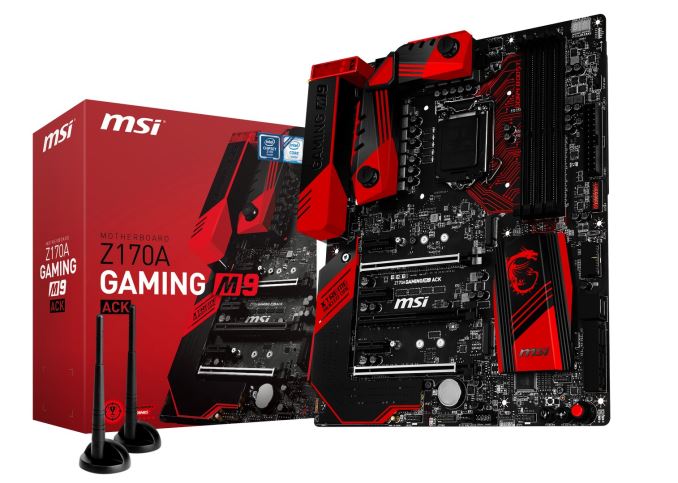








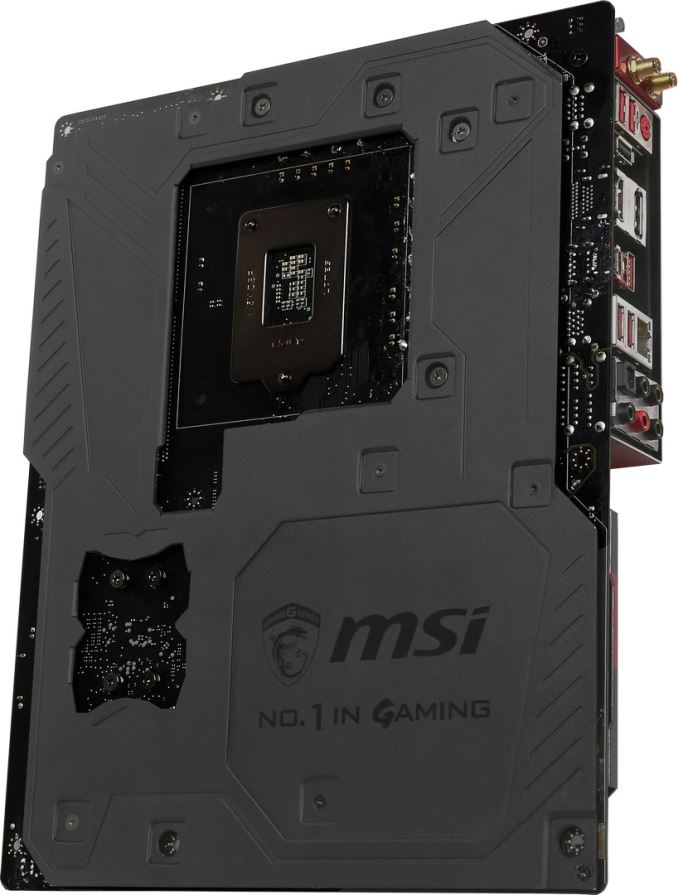
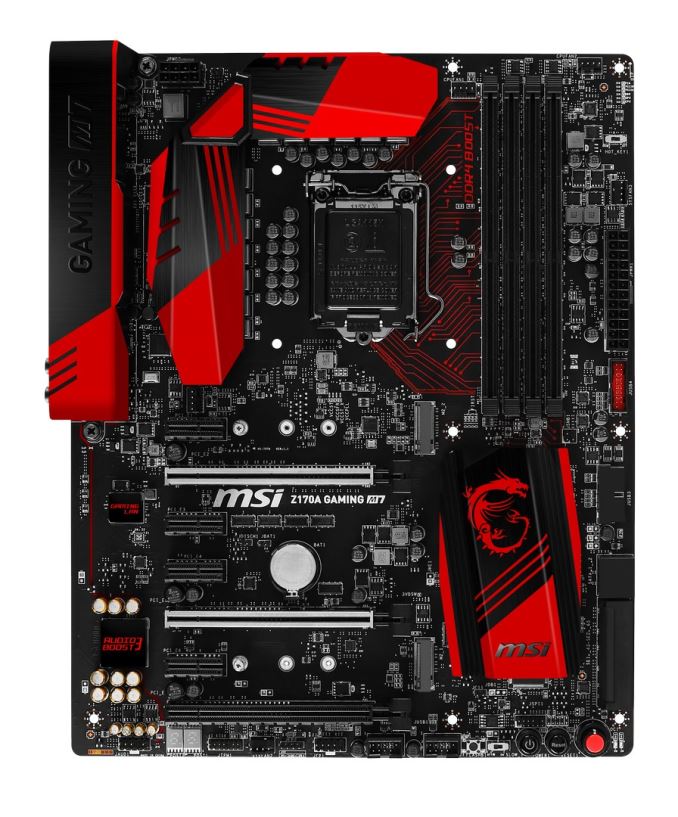







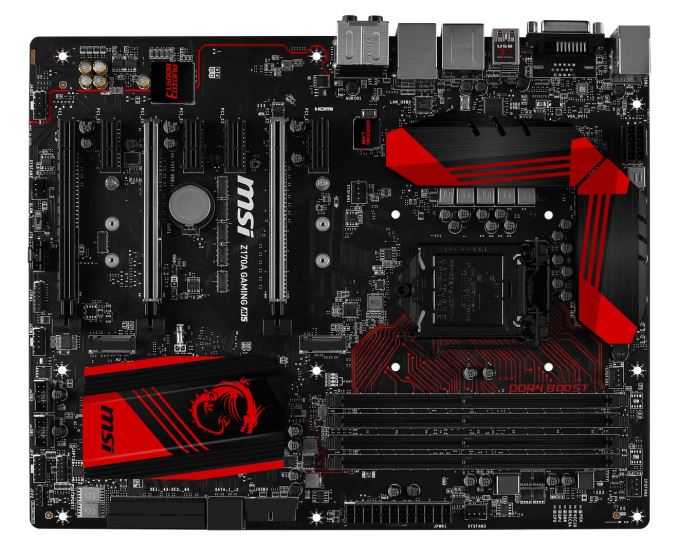
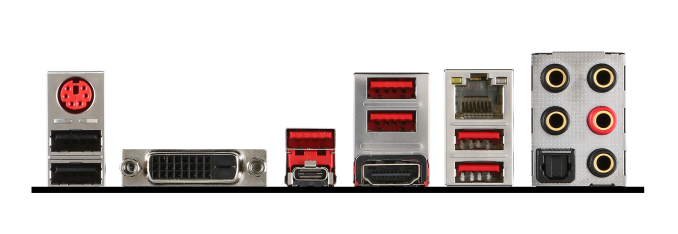






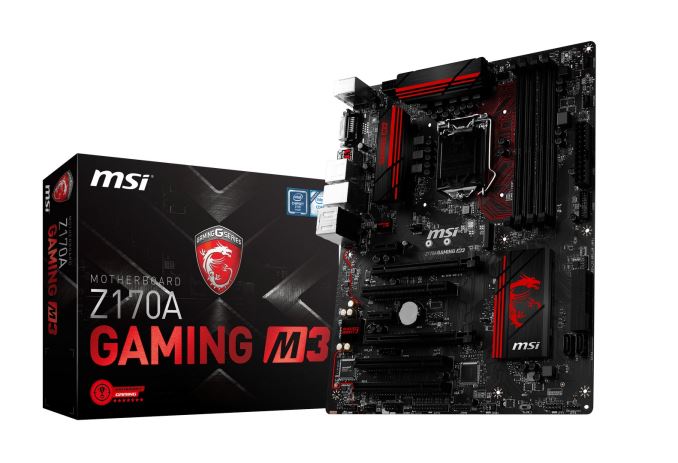







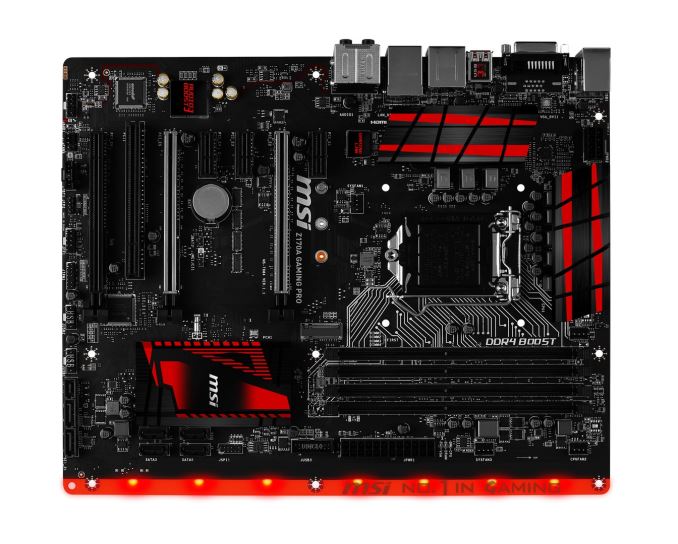















85 Comments
View All Comments
AndyTri - Thursday, August 6, 2015 - link
In the specifications it states: M.2, SATA and SATAe ports maximum support 1x M.2_PCIe + 6x SATAs or 1x M.2_SATA + 1x M.2_PCIe + 4x SATAs. Please refer to page 19 forM.2 slots with examples of various combination possibilities. On page 19 however it gives a lot more configuration options including 2x M.2_PCIe + 4x SATAs
althaz - Thursday, August 6, 2015 - link
I'm tempted by the Skylake i7 and the Asus Z170-Deluxe, but I need to see some real motherboard reviews first. Obviously that's not exactly feasible for this sort of thing where many motherboards are released all at once - but hopefully those reviews are coming :).Especially those POST tests, it's silly, but they make a huge impact on my purchasing decisions.
Ian Cutress - Thursday, August 6, 2015 - link
Hopefully I'll squeeze one or two out before IDF. Pretty sure five or six samples arrived in the run up to launch, I need to open a few boxes.meacupla - Thursday, August 6, 2015 - link
I guess we're going to be waiting a while for MSI mITX and mATX boards to show up?Currently, there's only one mATX board that supports SLI, and it's a super expensive one from Asus.
sweeper765 - Thursday, August 6, 2015 - link
Do you still lose sata ports when using m.2?Mikemk - Thursday, August 6, 2015 - link
What is SSIC?mrlithium - Friday, August 7, 2015 - link
"Super Speed Inter Chip", A standard concerned with low power, and signaling between chips on the motherboard, while still using USB 3.0 drivers. Something for motherboard makers to be concerned with.http://www.design-reuse.com/articles/34710/low-pow...
trsqd - Thursday, August 6, 2015 - link
Am I the only one here dreaming of a Mini-ATX board with a Xeon ( I know there's none yet for 1151, but think of Xeon-D ) or i5/7 with Iris Pro graphics ( not everyone is a hardcore gamer ) , with at least 2x M.2 (x4) slots ( imagine SM951 in Raid 0 ) and which can take at least 64GB RAM ? It would be my dream machine...what an amazing host that would be. Or even an Intel NUC with 2xM.2...maofthnun - Thursday, August 6, 2015 - link
Does anyone know if any of these boards support vt-d? Or is it only gonna be Q170?sweeper765 - Thursday, August 6, 2015 - link
Asus Z170-A question:If i populate the M.2 slot with pcie ssd would that consume any of the regular sata ports?
Manual says m.2 is shared with sata express but what about the 2 sata ports? Can they be used with m.2 at the same time?